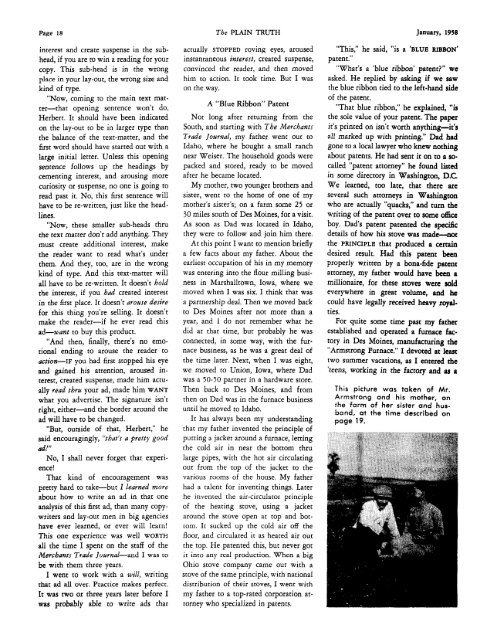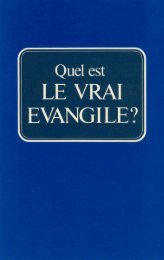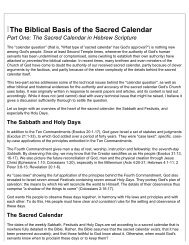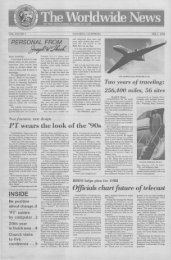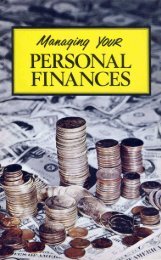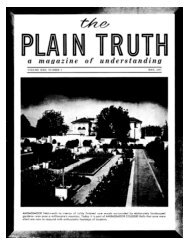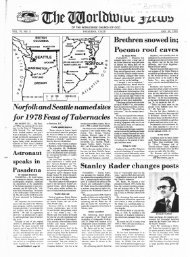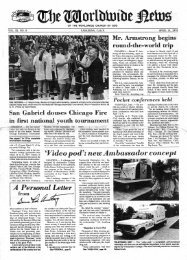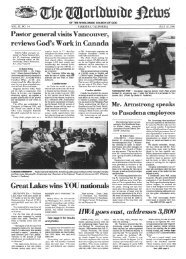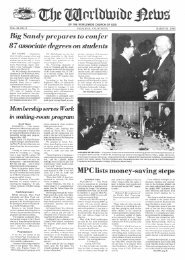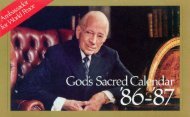Plain Truth 1958 (Vol XXIII No 01) Jan - Herbert W. Armstrong ...
Plain Truth 1958 (Vol XXIII No 01) Jan - Herbert W. Armstrong ...
Plain Truth 1958 (Vol XXIII No 01) Jan - Herbert W. Armstrong ...
You also want an ePaper? Increase the reach of your titles
YUMPU automatically turns print PDFs into web optimized ePapers that Google loves.
Page 18 The PLAIN TRUTH <strong>Jan</strong>uary, <strong>1958</strong><br />
interest and create suspense in the subhead,<br />
if you are to win a reading for your<br />
copy. This sub-head is in the wrong<br />
place in your lay-out, the wrong size and<br />
kind of type.<br />
“<strong>No</strong>w, coming to the main text matter-that<br />
opening sentence won’t do,<br />
<strong>Herbert</strong>. It should have been indicated<br />
on the lay-out to be in larger type than<br />
the balance of the text-matter, and the<br />
first word should have started out with a<br />
large initial letter. Unless this opening<br />
sentence follows up the headings by<br />
cementing interest, and arousing more<br />
curiosity or suspense, no one is going to<br />
read past it. <strong>No</strong>, this first sentence will<br />
have to be re-written, just like the headlines.<br />
“<strong>No</strong>w, these smaller sub-heads thru<br />
the text matter don’t add anything. They<br />
must create additional interest, make<br />
the reader want to read what’s under<br />
them. And they, too, are in the wrong<br />
kind of type. And this text-matter will<br />
all have to be re-written. It doesn’t hold<br />
the interest, if you bad created interest<br />
in the first place. It doesn’t aTouse desire<br />
for this thing you’re selling. It doesn’t<br />
make the reader-if he ever read this<br />
ad-want to buy this product.<br />
“And then, finally, there’s no emotional<br />
ending to arouse the reader to<br />
action-IF you had first stopped his eye<br />
and gained his attention, aroused interest,<br />
created suspense, made him actually<br />
read thru your ad, made him WANT<br />
what you advertise. The signature isn’t<br />
right, either-and the border around the<br />
ad will have to be changed.<br />
“But, outside of that, <strong>Herbert</strong>,” he<br />
said encouragingly, “that’s a pretty good<br />
d!”<br />
<strong>No</strong>, I shall never forget that experience!<br />
That kind of encouragement was<br />
pretty hard to take-but 1 learned more<br />
about how to write an ad in that one<br />
analysis of this first ad, than many copywriters<br />
and lay-out men in big agencies<br />
have ever learned, or ever will learn!<br />
This one experience was well WORTH<br />
all the time I spent on the staff of the<br />
Merchants Trade JournaGand I was to<br />
be with them three years.<br />
I went to work with a will, writing<br />
that ad all over. Practice makes perfect.<br />
It was two or three years later before I<br />
was probably able to write ads that<br />
actually STOPPED roving eyes, aroused<br />
instantaneous interest, created suspense,<br />
convinced the reader, and then moved<br />
him to action. It took time. But I was<br />
on the way.<br />
A “Blue Ribbon” Patent<br />
<strong>No</strong>t long after returning from the<br />
South, and starting with The Merchants<br />
Trade jounzal, my father went out to<br />
Idaho, where he bought a small ranch<br />
near Weiser. The household goods were<br />
packed and stored, ready to be moved<br />
after he became located.<br />
My mother, two younger brothers and<br />
sister, went to the home of one of my<br />
mother’s sister’s; on a farm some 25 or<br />
30 miles south of Des Moines, for a visit.<br />
As soon as Dad was located in Idaho,<br />
they were to follow and join him there.<br />
At this point I want to mention briefly<br />
a few facts about my father. About the<br />
earliest occupation of his in my memory<br />
was entering into the flour milling business<br />
in Marshalltown, Iowa, where we<br />
moved when I was six. I think that was<br />
a partnership deal. Then we moved back<br />
to Des Moines after not more than a<br />
year, and 1 do not remember what he<br />
did at that time, but probably he was<br />
connected, in some way, with the furnace<br />
business, as he was a great deal of<br />
the time later. Next, when I was eight,<br />
we moved to Union, Iowa, where Dad<br />
was a 50-50 partner in a hardware store.<br />
Then back to Des Moines, and from<br />
then on Dad was in the furnace business<br />
until he moved to Idaho.<br />
It has always been my understanding<br />
that my father invented the principle of<br />
putting a jacket around a furnace, letting<br />
the cold air in near the bottom thru<br />
large pipes, with the hot air circulating<br />
our from the top of the jacket to the<br />
various rooms of the house. My father<br />
had a talent for inventing things. Later<br />
he invented the air-circulator principle<br />
of the heating stove, using a jacket<br />
around the stove open at top and bottom.<br />
It sucked up the cold air off the<br />
floor, and circulated it as heated air out<br />
the top. He patented this, but never got<br />
it into any real production. When a big<br />
Ohio stove company came out with a<br />
stove of the same principle, with national<br />
distribution of their stoves, I went with<br />
my father to a top-rated corporation attorney<br />
who specialized in patents.<br />
“This,” he said, “is a ‘BLUE RIBBON’<br />
patent.”<br />
“What’s a ‘blue ribbon’ patent?” we<br />
asked. He replied by asking if we saw<br />
the blue ribbon tied to the left-hand side<br />
of the patent.<br />
“That blue ribbon,” he explained, “is<br />
the sole value of your patent. The paper<br />
it’s printed on isn’t worth anything-it’s<br />
all marked up with printing.” Dad had<br />
gone to a local lawyer who knew nothing<br />
about patents. He had sent it on to a so.<br />
called “patent attorney” he found listed<br />
in some directory in Washington, D.C<br />
We learned, too late, that there are<br />
several such attorneys in Washington<br />
who are actually “quacks,” and turn the<br />
writing of the patent over to some office<br />
boy. Dad’s patent patented the specific<br />
details of how his stove was made-not<br />
the PRINCIPLE that produced a certain<br />
desired result. Had this patent been<br />
properly written by a bona-fide patent<br />
attorney, my father would have been a<br />
millionaire, for these stoves were sold<br />
everywhere in great volume, and he<br />
could have legally received heavy royalties.<br />
For quite some time past my father<br />
established and operated a furnace factory<br />
in Des Moines, manufacturing the<br />
“<strong>Armstrong</strong> Furnace.’’ I devoted at least<br />
two summer vacations, as I entered the<br />
’teens, working in the factory and BS a<br />
This picture was taken of Mr.<br />
<strong>Armstrong</strong> and his mother, on<br />
the farm of her sister and husband,<br />
at the time described on<br />
page 19.


